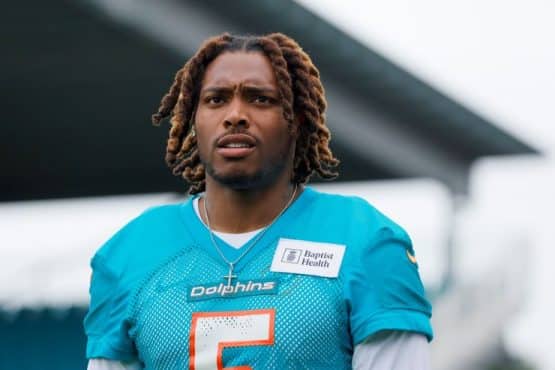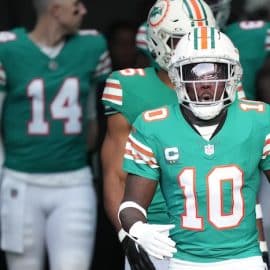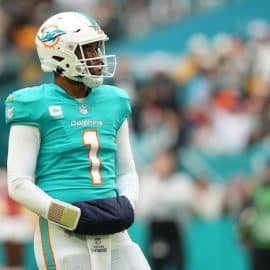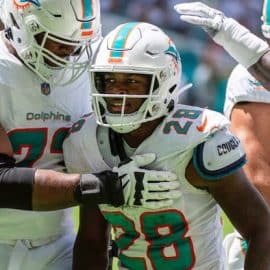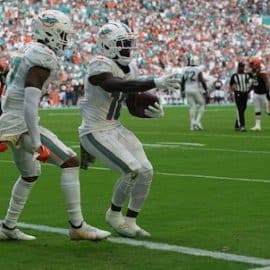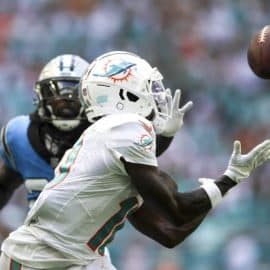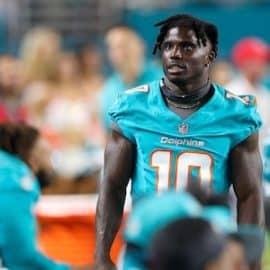While the Dolphins players are off resting and relaxing, many questions have been posed about what steps the Dolphins offense will need to take to put more points on the scoreboard and win more games.
First, last season, when the Dolphins hired Mike Sherman to be the offensive coordinator, news of the hiring sparked much optimism amongst Dolphins fans. After all, Sherman worked as the head coach for Brett Favre and a dynamic passing offense, worked in Houston with Kubiak with newly acquired Matt Schaub and Andre Johnson, and finally had a great rapport with Ryan Tannehill at Texas A&M. Heck, Tannehill was probably the Dolphins choice because of Mike Sherman, being his former coach at Texas A&M.
However, how did the Dolphins offense improve when after one year of having an offense that ranked 27th in points, 27th in yards, and 26th in pass yards per game. As a result, many Dolfans were calling for Sherman’s head and wanted to move on to another re-tread offensive coordinator in Norv Turner. Many Dolfans uttered the name Dan Henning several times on twitter and wanted the Dolphins to do more than just ground and pound right into the opposing defenses, at least the Dolphins could find solace in their run game at 17th averaging 112.6 yards per game.
The reality of the Dolphins offense is there were no offensive weapons to begin with (after making the Brandon Marshall trade) and calling plays became more of an adventure for Mike Sherman with the lack of pass catching and a running tight end, a lack of blocking upfront to spring Reggie Bush, and a lack of execution by third and fourth receivers who dropped, fumbled, or couldn’t out run sailing passes to help rookie QB Ryan Tannehill. The personnel moves in the offseason did not mesh well with the offense that Joe Philbin and Mike Sherman were accustomed to running.
After looking at the season as a whole, Sherman’s best and worst job of play calling could be wrapped up into one game: Week 4 versus the Arizona Cardinals. This is the game where the Dolphins played well enough to win and poorly enough to lose. It was a tale of two halves. After a very counter-productive first quarter by both the Cardinals and Dolphins, the Dolphins got on the board with a field goal. Later after a 95 yard drive and a Jorvorskie Lane plunge into the end zone, the Dolphins made it 10-0. This drive included 2 passes, one a 57 yard pass and another, a 19 yard pass in order to overcome a 14 yard loss on a sack. This drive proved most impressive at the time by rookie QB Ryan Tannehill. It was the quickest drive for a touchdown in that only 3:49 elapsed off the clock. An eight play drive and a touchdown was music to the ears of all Dolfans watching.
However, the second half, riding a 13-0 lead was a completely different story. The offense seemed to go into a shell. First the Dolphins opening drive of the 3rd quarter led to a missed field goal after a 2:17 drive on a play call sequence of a pass for 6 yards, a run by Reggie Bush for 1 yard, a pass to Hartline for 30 yards, and run for negative yardage on 1st down and then a couple of incomplete passes to Davone Bess. The field goal resulted in a miss by Carpenter with Dolfans clamoring for better play calls and more #Fireland talk. What was most un-nerving about this drive was the fact that the Dolphins had the Cardinals on the ropes. Their defense was on the ropes and a 20-0 lead in the 3rd quarter would have been close to smooth sailing to victory for Miami.
The next offensive drive brought about some puzzling play calls: starting at the Miami 16, on first down, Tannehill passed to Bess for 16 yards. Then instead of maybe getting the receivers out wide and throwing the ball into the flat or even a screen pass with a furious pass rush by Arizona, the Dolphins chose run and Bush lost -5 yards. Already in a game where Reggie Bush was hobbled by a knee strain, they ran him on first down, right at the defense. By the time he bounced outside, the Cardinals had the edge and drove him back. This was frustrating to say the least. Even more frustrating was the next play call: pass to Bess that was almost an interception: 3 yards, then even after a huge pass interference call that was drawn by Brian Hartline, the Dolphins punted on this drive. Total time of the drive was 3:05 and no points. Lead 13-7.
Fast forward to the end of the 4th quarter and leading 13-7, Sherman calls Fake FB toss to Reggie Bush and Sam Acho happily meets him for a 9 yard loss. Still leading at the end of 3 quarters 13-7, this element of trickery fooled every Dolfan, but not the Cardinals defense that pursued Bush with a fury. On the next play, a pass on third down leading to another 9 yard loss and a blown drive with a chance to take some momentum into the third quarter.
The Dolphins sadly, lost this game in overtime on a fumble recovery by Arizona after Tannehill got major pressure. Can we call this game the best and worst game? Sure. Statistically, this was the best game of the season passing by the Dolphins. In fact, Tannehill threw for 1 touch down and 431 yards passing. 233 yards to Brian Hartline alone. However, none of these statistics really matter because the Dolphins didn’t win the game nor did they make the playoffs.
So, what steps should Mike Sherman look to take into next season?
For starters, the Dolphins offense has very limited big play capability. While Brian Hartline became the only deep threat the Dolphins had, there was no clear cut consistency by Reggie Bush nor any other receivers on the team. Surely, Davone Bess contributed to the offense by catching 61 passes for 778 yards. Most impressive was his 12.8 yards per catch which allowed him to stretch the field a bit.
However, the biggest disappointment was Reggie Bush. Even though Bush rushed for 986 yards on 6 touchdowns, Bush proved inconsistent. This was evident from the beginning of the season until the final three weeks. The final three weeks showed that Bush was misused in the offense, especially when he began to catch passes lined up out wide or out of the back field. When Reggie Bush was cold, down went Miami. The fumble versus the Jets leading, leading to an eventual loss. Fumble versus Tennessee lead to a 37-3 whipping. Bottom line, the Dolphins seldom won a game when turning over the ball more than once.
If the Dolphins are going to win more games than last season, considering the Dolphins spend 36 million wisely to upgrade the offense, Sherman has to make big calls at the right time. Sherman has to stick to the play calls that got them the lead in the first place. If running is what is winning the game, then stick with it until the defense adjusts to it. If passing for over 400 yards, then abandon the run game. It’s really not that simple, but when you have a team on the ropes and the receivers are getting separation, it’s not wise to get conservative and play not to win. This motto has rung true over the course of the past decade for Miami teams. Get a big lead then run the ball. Ask teams such as the Patriots and 49ers if that is exactly how to win games. Frankly, if a team adjusts to the Dolphins passing game, then that’s where the play call has to be unpredictable instead of doing the same exact thing. Throw in a screen pass to a Lamar Miller or run the full back to get a few yards. Run a zone read to throw off the defense. Even consider running a few wild cat plays with Daniel Thomas. These are the wrinkles that the Dolphins have implemented into their offensive game plan that have been successful in the past.
Quite honestly, the Dolphins truly are limited at this point going into the offseason. An offensive makeover with a playmaking wide receiver and a deep threat are necessary to get this offense in rhythm. The Dolphins play calls and the evolution of Mike Sherman’s offense will be necessary and a key to the success of the Dolphins. Otherwise, it will be another dull season and more questions than answers this time next year.
Add The Sports Daily to your Google News Feed!
